service indicator FORD POLICE INTERCEPTOR UTILITY 2017 1.G User Guide
[x] Cancel search | Manufacturer: FORD, Model Year: 2017, Model line: POLICE INTERCEPTOR UTILITY, Model: FORD POLICE INTERCEPTOR UTILITY 2017 1.GPages: 360, PDF Size: 4.06 MB
Page 128 of 360
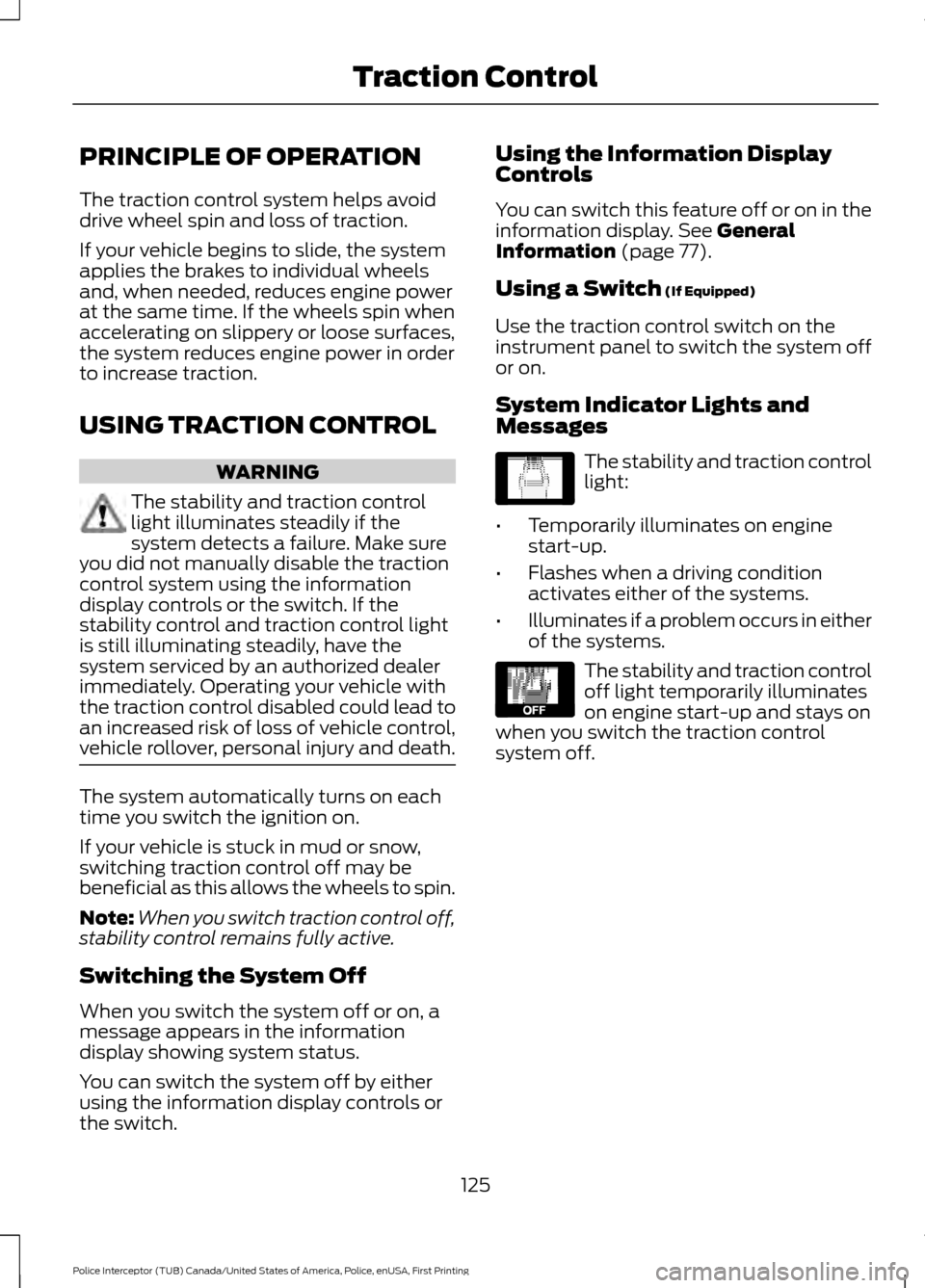
PRINCIPLE OF OPERATION
The traction control system helps avoid
drive wheel spin and loss of traction.
If your vehicle begins to slide, the system
applies the brakes to individual wheels
and, when needed, reduces engine power
at the same time. If the wheels spin when
accelerating on slippery or loose surfaces,
the system reduces engine power in order
to increase traction.
USING TRACTION CONTROL
WARNING
The stability and traction control
light illuminates steadily if the
system detects a failure. Make sure
you did not manually disable the traction
control system using the information
display controls or the switch. If the
stability control and traction control light
is still illuminating steadily, have the
system serviced by an authorized dealer
immediately. Operating your vehicle with
the traction control disabled could lead to
an increased risk of loss of vehicle control,
vehicle rollover, personal injury and death. The system automatically turns on each
time you switch the ignition on.
If your vehicle is stuck in mud or snow,
switching traction control off may be
beneficial as this allows the wheels to spin.
Note:
When you switch traction control off,
stability control remains fully active.
Switching the System Off
When you switch the system off or on, a
message appears in the information
display showing system status.
You can switch the system off by either
using the information display controls or
the switch. Using the Information Display
Controls
You can switch this feature off or on in the
information display. See General
Information (page 77).
Using a Switch
(If Equipped)
Use the traction control switch on the
instrument panel to switch the system off
or on.
System Indicator Lights and
Messages The stability and traction control
light:
• Temporarily illuminates on engine
start-up.
• Flashes when a driving condition
activates either of the systems.
• Illuminates if a problem occurs in either
of the systems. The stability and traction control
off light temporarily illuminates
on engine start-up and stays on
when you switch the traction control
system off.
125
Police Interceptor (TUB) Canada/United States of America, Police, enUSA, First Printing Traction ControlE138639 E130458
Page 162 of 360

This program is separate from the New
Vehicle Limited Warranty, but the coverage
is concurrent with the powertrain coverage
period of your vehicle.
Canadian customers who require roadside
assistance, call 1-800-665-2006.
Vehicles Sold in Canada: Using
Roadside Assistance
Complete the roadside assistance
identification card and place it in your
wallet for quick reference.
In Canada, this card is found in the
Warranty Guide in the glove compartment
of your vehicle.
Vehicles Sold in Canada: Roadside
Assistance Program Coverage
The service is available 24 hours a day,
seven days a week.
Canadian roadside coverage and benefits
may differ from the U.S. coverage.
For complete program coverage details
you may contact your dealer, you can call
us in Canada at 1-800-665-2006, or visit
our website at www.ford.ca.
HAZARD WARNING FLASHERS
Note:
If used when the vehicle is not
running, the battery will lose charge. There
may be insufficient power to restart your
vehicle. The hazard warning button is
located on the instrument panel.
Use it when your vehicle is
creating a safety hazard for other
motorists.
• Press the button to turn on the hazard
warning function, and the front and
rear direction indicators will flash.
• Press the button again to turn them
off. FUEL SHUTOFF WARNING
Failure to inspect and, if necessary,
repair fuel leaks after a collision may
increase the risk of fire and serious
injury. Ford Motor Company recommends
that the fuel system be inspected by an
authorized dealer after any collision. In the event of a moderate to severe
collision, this vehicle includes a fuel pump
shutoff feature that stops the flow of fuel
to the engine. Not every impact will cause
a shutoff.
Should your vehicle shut off after a
collision, you may restart your vehicle. For
vehicles equipped with a key system:
1. Switch off the ignition.
2. Switch on the ignition.
3. Repeat Steps 1 and 2 to re-enable the
fuel pump.
For vehicles equipped with a push button
start system:
1. Press the START/STOP button to
switch off the ignition.
2. Press the brake pedal and press the START/STOP
button to switch on the
ignition.
3. Remove your foot from the brake pedal
and press the
START/STOP button
to switch off the ignition.
4. You can either attempt to start the engine by pressing the brake pedal and
the
START/STOP button, or switch
on the ignition only by pressing the
START/STOP
button without
pressing the brake pedal. Both ways
re-enable the fuel system.
159
Police Interceptor (TUB) Canada/United States of America, Police, enUSA, First Printing Roadside Emergencies
Page 165 of 360
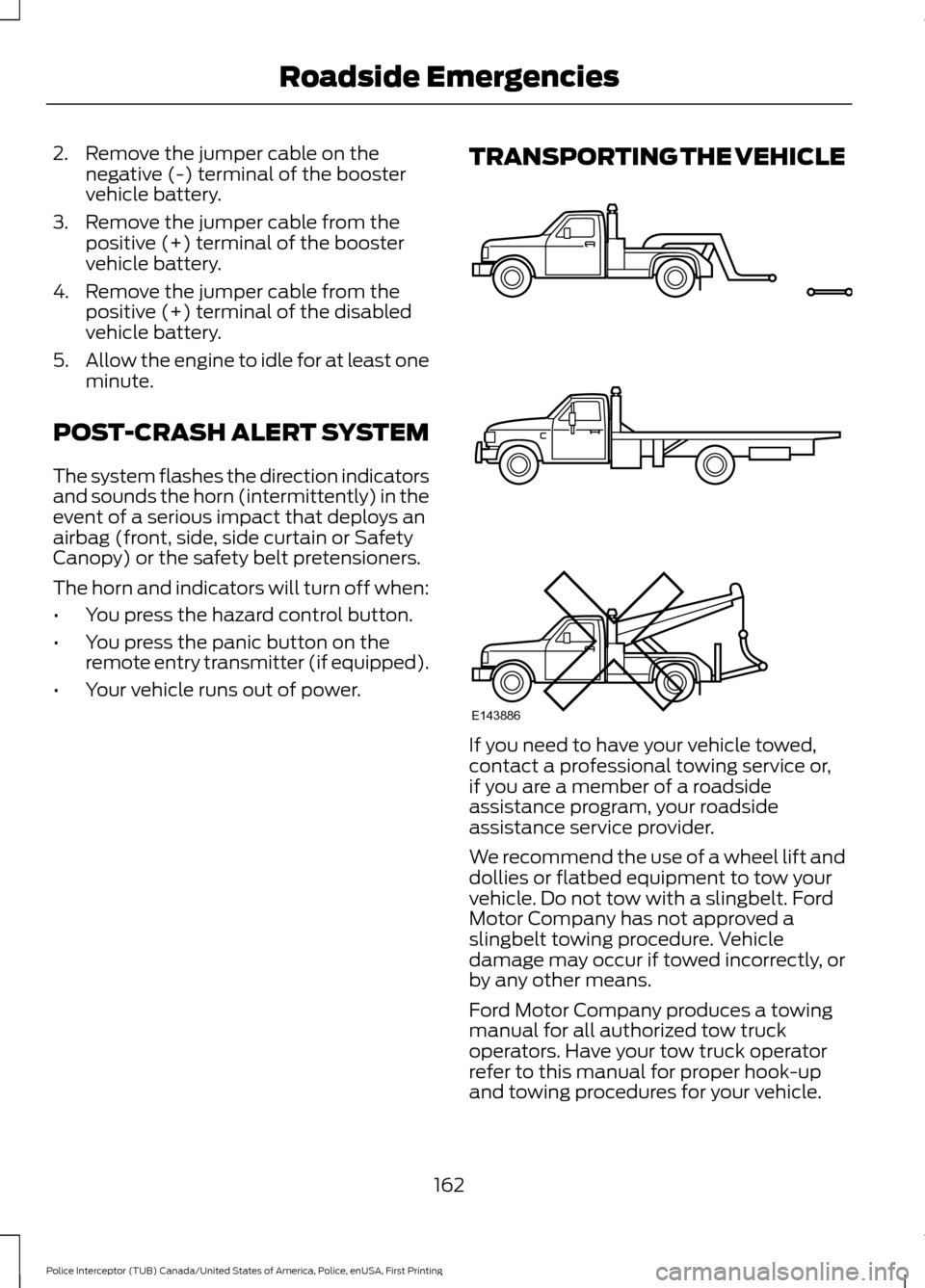
2. Remove the jumper cable on the
negative (-) terminal of the booster
vehicle battery.
3. Remove the jumper cable from the positive (+) terminal of the booster
vehicle battery.
4. Remove the jumper cable from the positive (+) terminal of the disabled
vehicle battery.
5. Allow the engine to idle for at least one
minute.
POST-CRASH ALERT SYSTEM
The system flashes the direction indicators
and sounds the horn (intermittently) in the
event of a serious impact that deploys an
airbag (front, side, side curtain or Safety
Canopy) or the safety belt pretensioners.
The horn and indicators will turn off when:
• You press the hazard control button.
• You press the panic button on the
remote entry transmitter (if equipped).
• Your vehicle runs out of power. TRANSPORTING THE VEHICLE
If you need to have your vehicle towed,
contact a professional towing service or,
if you are a member of a roadside
assistance program, your roadside
assistance service provider.
We recommend the use of a wheel lift and
dollies or flatbed equipment to tow your
vehicle. Do not tow with a slingbelt. Ford
Motor Company has not approved a
slingbelt towing procedure. Vehicle
damage may occur if towed incorrectly, or
by any other means.
Ford Motor Company produces a towing
manual for all authorized tow truck
operators. Have your tow truck operator
refer to this manual for proper hook-up
and towing procedures for your vehicle.
162
Police Interceptor (TUB) Canada/United States of America, Police, enUSA, First Printing Roadside EmergenciesE143886
Page 204 of 360
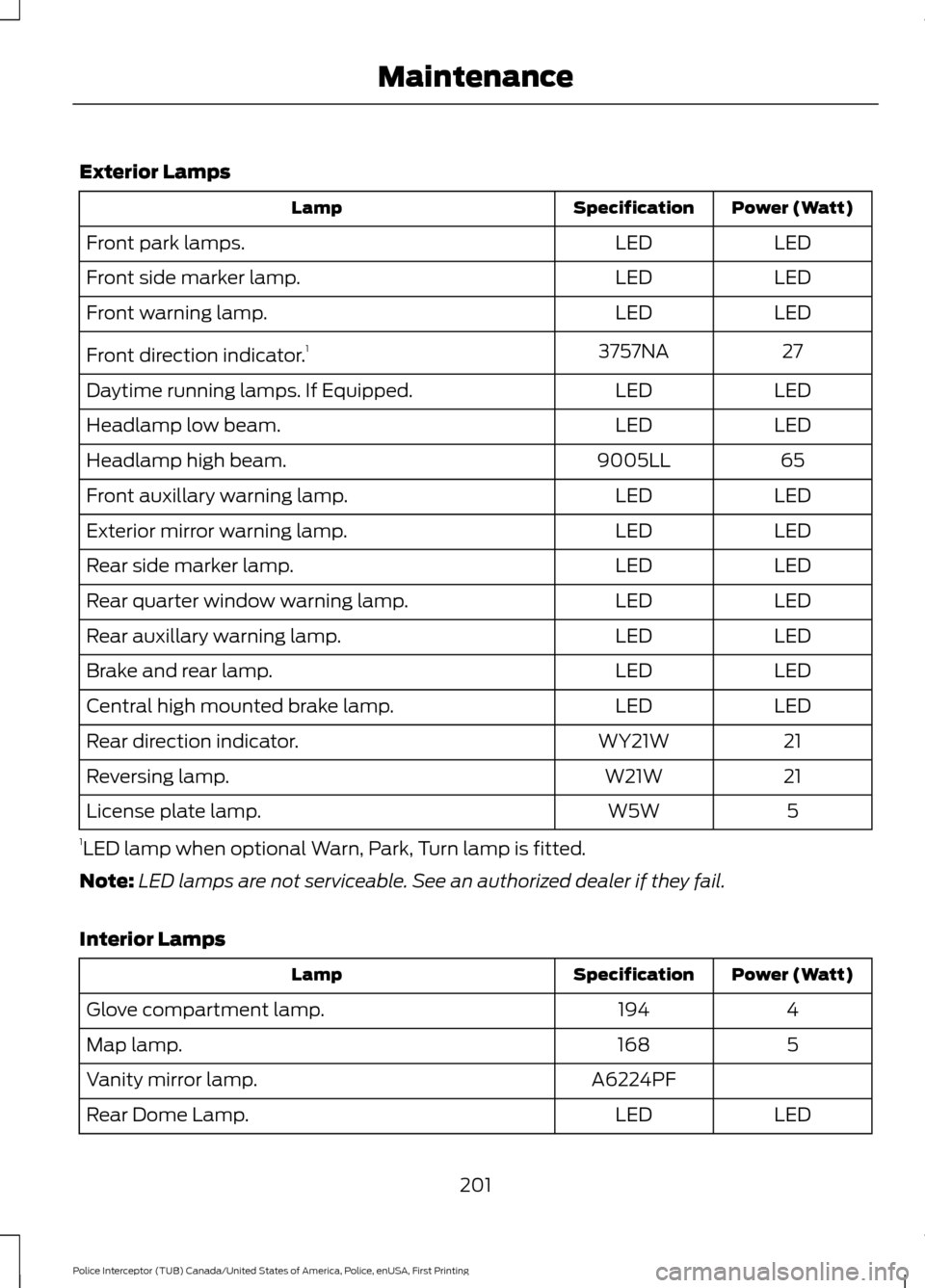
Exterior Lamps
Power (Watt)
Specification
Lamp
LED
LED
Front park lamps.
LED
LED
Front side marker lamp.
LED
LED
Front warning lamp.
27
3757NA
Front direction indicator. 1
LED
LED
Daytime running lamps. If Equipped.
LED
LED
Headlamp low beam.
65
9005LL
Headlamp high beam.
LED
LED
Front auxillary warning lamp.
LED
LED
Exterior mirror warning lamp.
LED
LED
Rear side marker lamp.
LED
LED
Rear quarter window warning lamp.
LED
LED
Rear auxillary warning lamp.
LED
LED
Brake and rear lamp.
LED
LED
Central high mounted brake lamp.
21
WY21W
Rear direction indicator.
21
W21W
Reversing lamp.
5
W5W
License plate lamp.
1 LED lamp when optional Warn, Park, Turn lamp is fitted.
Note: LED lamps are not serviceable. See an authorized dealer if they fail.
Interior Lamps Power (Watt)
Specification
Lamp
4
194
Glove compartment lamp.
5
168
Map lamp.
A6224PF
Vanity mirror lamp.
LED
LED
Rear Dome Lamp.
201
Police Interceptor (TUB) Canada/United States of America, Police, enUSA, First Printing Maintenance
Page 233 of 360
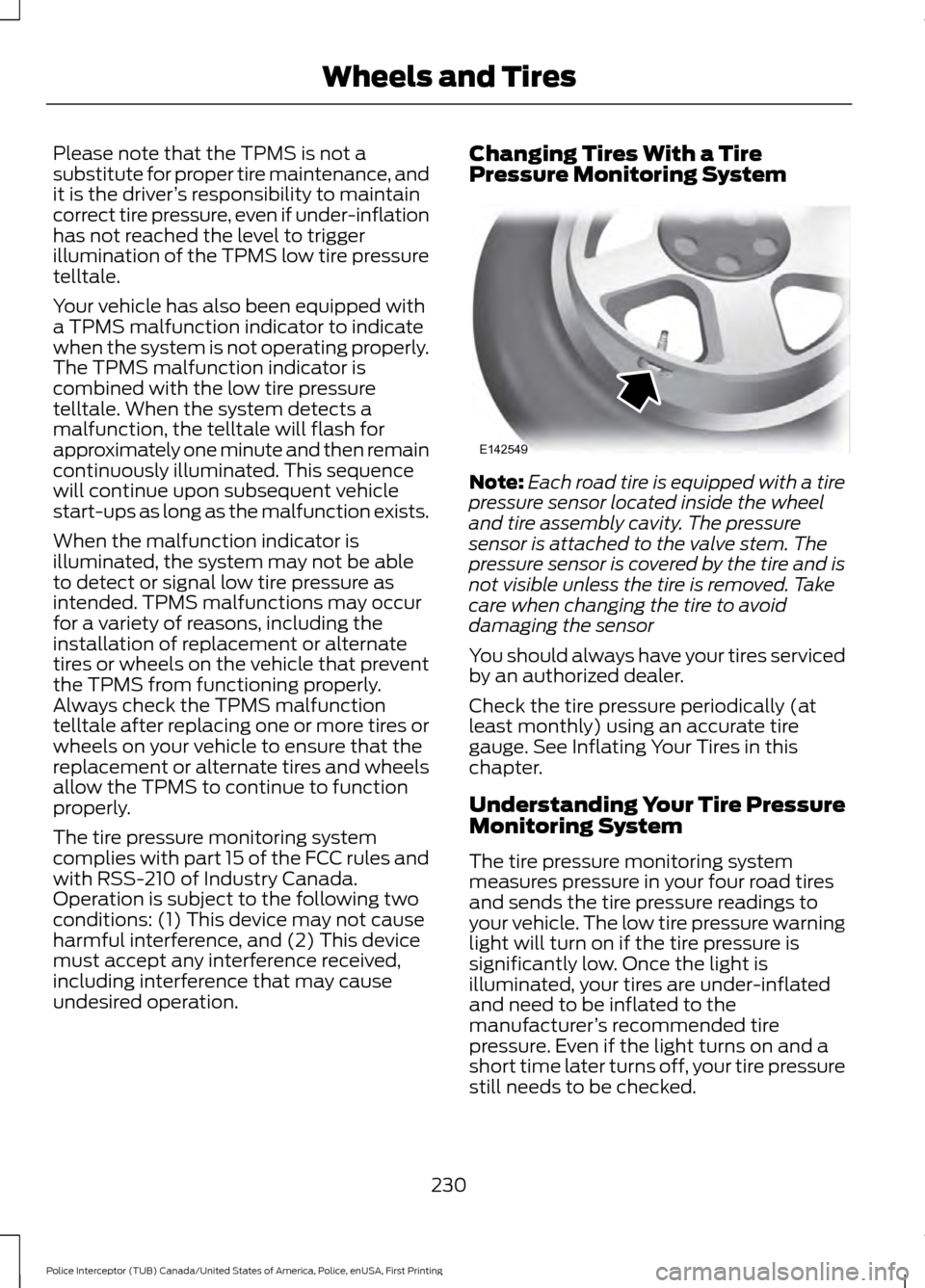
Please note that the TPMS is not a
substitute for proper tire maintenance, and
it is the driver
’s responsibility to maintain
correct tire pressure, even if under-inflation
has not reached the level to trigger
illumination of the TPMS low tire pressure
telltale.
Your vehicle has also been equipped with
a TPMS malfunction indicator to indicate
when the system is not operating properly.
The TPMS malfunction indicator is
combined with the low tire pressure
telltale. When the system detects a
malfunction, the telltale will flash for
approximately one minute and then remain
continuously illuminated. This sequence
will continue upon subsequent vehicle
start-ups as long as the malfunction exists.
When the malfunction indicator is
illuminated, the system may not be able
to detect or signal low tire pressure as
intended. TPMS malfunctions may occur
for a variety of reasons, including the
installation of replacement or alternate
tires or wheels on the vehicle that prevent
the TPMS from functioning properly.
Always check the TPMS malfunction
telltale after replacing one or more tires or
wheels on your vehicle to ensure that the
replacement or alternate tires and wheels
allow the TPMS to continue to function
properly.
The tire pressure monitoring system
complies with part 15 of the FCC rules and
with RSS-210 of Industry Canada.
Operation is subject to the following two
conditions: (1) This device may not cause
harmful interference, and (2) This device
must accept any interference received,
including interference that may cause
undesired operation. Changing Tires With a Tire
Pressure Monitoring System
Note:
Each road tire is equipped with a tire
pressure sensor located inside the wheel
and tire assembly cavity. The pressure
sensor is attached to the valve stem. The
pressure sensor is covered by the tire and is
not visible unless the tire is removed. Take
care when changing the tire to avoid
damaging the sensor
You should always have your tires serviced
by an authorized dealer.
Check the tire pressure periodically (at
least monthly) using an accurate tire
gauge. See Inflating Your Tires in this
chapter.
Understanding Your Tire Pressure
Monitoring System
The tire pressure monitoring system
measures pressure in your four road tires
and sends the tire pressure readings to
your vehicle. The low tire pressure warning
light will turn on if the tire pressure is
significantly low. Once the light is
illuminated, your tires are under-inflated
and need to be inflated to the
manufacturer ’s recommended tire
pressure. Even if the light turns on and a
short time later turns off, your tire pressure
still needs to be checked.
230
Police Interceptor (TUB) Canada/United States of America, Police, enUSA, First Printing Wheels and TiresE142549
Page 236 of 360

How Temperature Affects Your Tire
Pressure
The tire pressure monitoring system
monitors tire pressure in each pneumatic
tire. While driving in a normal manner, a
typical passenger tire inflation pressure
may increase about 2 to 4 psi (14 to 28
kPa) from a cold start situation. If the
vehicle is stationary overnight with the
outside temperature significantly lower
than the daytime temperature, the tire
pressure may decrease about 3 psi (21
kPa) for a drop of 30°F (17°C) in ambient
temperature. This lower pressure value
may be detected by the tire pressure
monitoring system as being significantly
lower than the recommended inflation
pressure and activate the system warning
light for low tire pressure. If the low tire
pressure warning light is on, visually check
each tire to verify that no tire is flat. If one
or more tires are flat, repair as necessary.
Check the air pressure in the road tires. If
any tire is under-inflated, carefully drive
the vehicle to the nearest location where
air can be added to the tires. Inflate all the
tires to the recommended inflation
pressure.
CHANGING A ROAD WHEEL
WARNINGS
The use of tire sealant may damage
your tire pressure monitoring system
and should only be used in roadside
emergencies. If you must use a sealant, the
Ford Tire Mobility Kit sealant should be
used. The tire pressure monitoring system
sensor and valve stem on the wheel must
be replaced by an authorized dealer after
use of the sealant. See Tire Pressure Monitoring
System (page 229). If the tire
pressure monitor sensor becomes
damaged, it will no longer function. Note:
The tire pressure monitoring system
indicator light will illuminate when the spare
tire is in use until the spare ’s tire pressure
monitoring system sensor is trained.
If you get a flat tire while driving, do not
apply the brake heavily. Instead, gradually
decrease your speed. Hold the steering
wheel firmly and slowly move to a safe
place on the side of the road.
Have a flat serviced by an authorized
dealer in order to prevent damage to the
tire pressure monitoring system sensors.
See
Tire Pressure Monitoring System
(page 229). Replace the spare tire with a
road tire as soon as possible. During
repairing or replacing of the flat tire, have
the authorized dealer inspect the tire
pressure monitoring system sensor for
damage.
Dissimilar Spare Wheel and Tire
Assembly Information WARNING
Failure to follow these guidelines
could result in an increased risk of
loss of vehicle control, injury or death.
If you have a dissimilar spare wheel and
tire, then it is intended for temporary use
only. This means that if you need to use it,
you should replace it as soon as possible
with a road wheel and tire assembly that
is the same size and type as the road tires
and wheels that were originally provided
by Ford. If the dissimilar spare tire or wheel
is damaged, it should be replaced rather
than repaired.
A dissimilar spare wheel and tire assembly
is defined as a spare wheel and tire
assembly that is different in brand, size or
appearance from the road tires and wheels
and can be one of three types:
233
Police Interceptor (TUB) Canada/United States of America, Police, enUSA, First Printing Wheels and Tires
Page 306 of 360
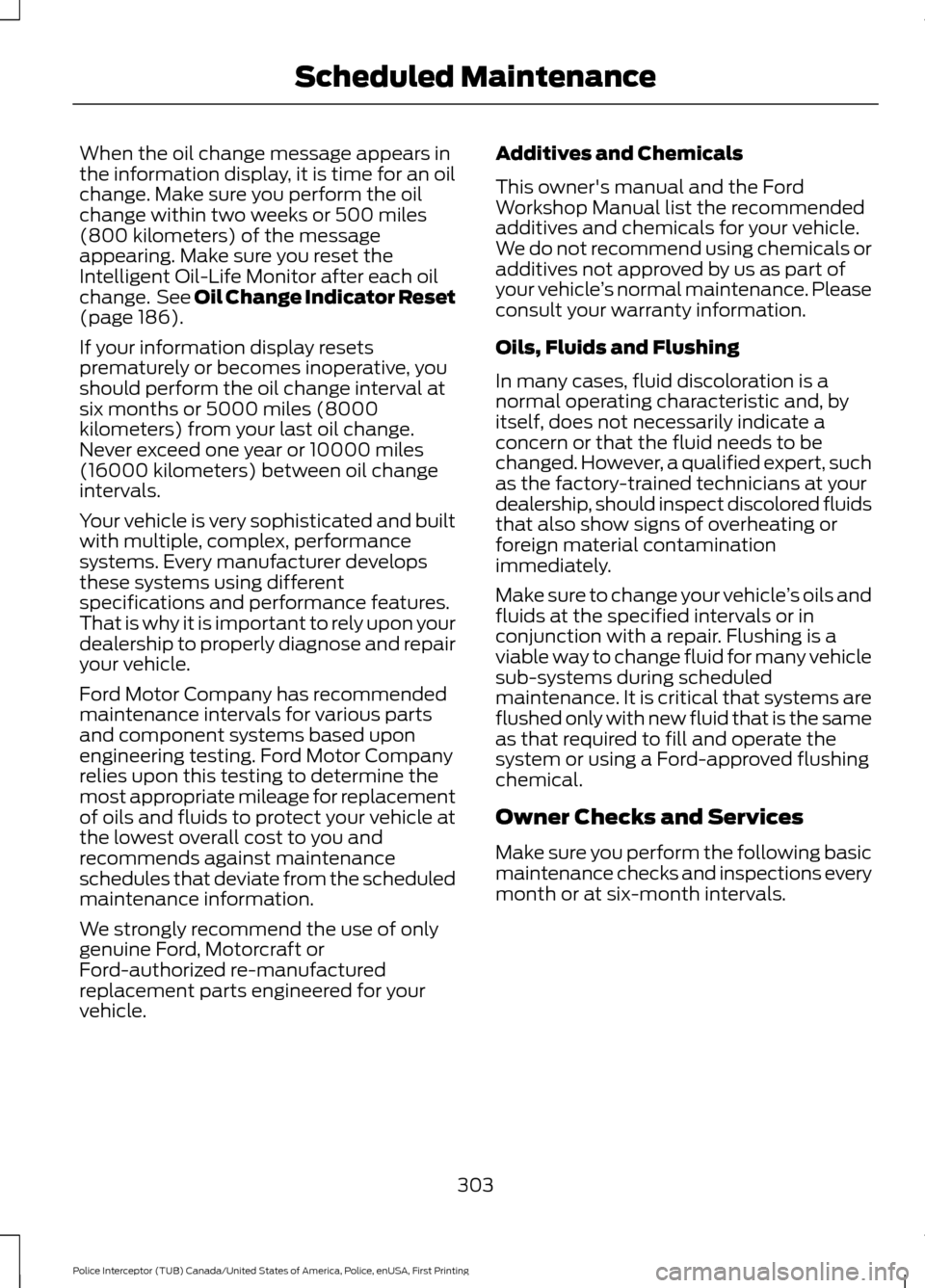
When the oil change message appears in
the information display, it is time for an oil
change. Make sure you perform the oil
change within two weeks or 500 miles
(800 kilometers) of the message
appearing. Make sure you reset the
Intelligent Oil-Life Monitor after each oil
change. See Oil Change Indicator Reset
(page 186).
If your information display resets
prematurely or becomes inoperative, you
should perform the oil change interval at
six months or 5000 miles (8000
kilometers) from your last oil change.
Never exceed one year or 10000 miles
(16000 kilometers) between oil change
intervals.
Your vehicle is very sophisticated and built
with multiple, complex, performance
systems. Every manufacturer develops
these systems using different
specifications and performance features.
That is why it is important to rely upon your
dealership to properly diagnose and repair
your vehicle.
Ford Motor Company has recommended
maintenance intervals for various parts
and component systems based upon
engineering testing. Ford Motor Company
relies upon this testing to determine the
most appropriate mileage for replacement
of oils and fluids to protect your vehicle at
the lowest overall cost to you and
recommends against maintenance
schedules that deviate from the scheduled
maintenance information.
We strongly recommend the use of only
genuine Ford, Motorcraft or
Ford-authorized re-manufactured
replacement parts engineered for your
vehicle. Additives and Chemicals
This owner's manual and the Ford
Workshop Manual list the recommended
additives and chemicals for your vehicle.
We do not recommend using chemicals or
additives not approved by us as part of
your vehicle
’s normal maintenance. Please
consult your warranty information.
Oils, Fluids and Flushing
In many cases, fluid discoloration is a
normal operating characteristic and, by
itself, does not necessarily indicate a
concern or that the fluid needs to be
changed. However, a qualified expert, such
as the factory-trained technicians at your
dealership, should inspect discolored fluids
that also show signs of overheating or
foreign material contamination
immediately.
Make sure to change your vehicle ’s oils and
fluids at the specified intervals or in
conjunction with a repair. Flushing is a
viable way to change fluid for many vehicle
sub-systems during scheduled
maintenance. It is critical that systems are
flushed only with new fluid that is the same
as that required to fill and operate the
system or using a Ford-approved flushing
chemical.
Owner Checks and Services
Make sure you perform the following basic
maintenance checks and inspections every
month or at six-month intervals.
303
Police Interceptor (TUB) Canada/United States of America, Police, enUSA, First Printing Scheduled Maintenance
Page 353 of 360
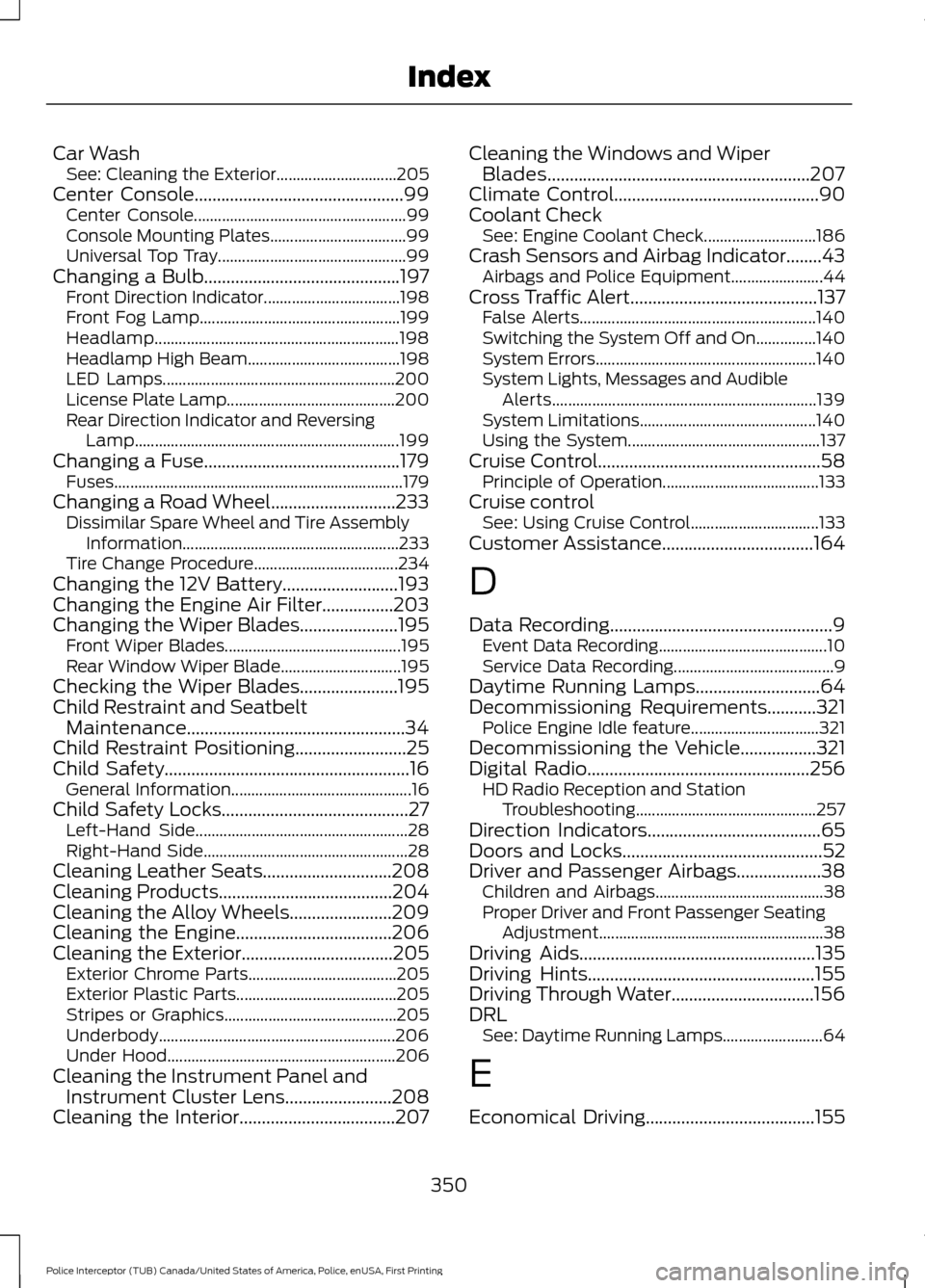
Car Wash
See: Cleaning the Exterior.............................. 205
Center Console...............................................99
Center Console..................................................... 99
Console Mounting Plates.................................. 99
Universal Top Tray............................................... 99
Changing a Bulb............................................197 Front Direction Indicator.................................. 198
Front Fog Lamp.................................................. 199
Headlamp............................................................. 198
Headlamp High Beam...................................... 198
LED Lamps.......................................................... 200
License Plate Lamp.......................................... 200
Rear Direction Indicator and Reversing Lamp.................................................................. 199
Changing a Fuse............................................179 Fuses........................................................................\
179
Changing a Road Wheel............................233 Dissimilar Spare Wheel and Tire Assembly
Information...................................................... 233
Tire Change Procedure.................................... 234
Changing the 12V Battery..........................193
Changing the Engine Air Filter................203
Changing the Wiper Blades
......................195
Front Wiper Blades............................................ 195
Rear Window Wiper Blade.............................. 195
Checking the Wiper Blades......................195
Child Restraint and Seatbelt Maintenance.................................................34
Child Restraint Positioning.........................25
Child Safety.......................................................16 General Information............................................. 16
Child Safety Locks..........................................27 Left-Hand Side..................................................... 28
Right-Hand Side................................................... 28
Cleaning Leather Seats.............................208
Cleaning Products
.......................................204
Cleaning the Alloy Wheels.......................209
Cleaning the Engine
...................................206
Cleaning the Exterior..................................205
Exterior Chrome Parts..................................... 205
Exterior Plastic Parts........................................ 205
Stripes or Graphics........................................... 205
Underbody........................................................... 206
Under Hood......................................................... 206
Cleaning the Instrument Panel and Instrument Cluster Lens........................208
Cleaning the Interior...................................207 Cleaning the Windows and Wiper
Blades...........................................................207
Climate Control
..............................................90
Coolant Check See: Engine Coolant Check............................ 186
Crash Sensors and Airbag Indicator........43 Airbags and Police Equipment....................... 44
Cross Traffic Alert
..........................................137
False Alerts........................................................... 140
Switching the System Off and On...............140
System Errors....................................................... 140
System Lights, Messages and Audible Alerts.................................................................. 139
System Limitations............................................ 140
Using the System................................................ 137
Cruise Control
..................................................58
Principle of Operation....................................... 133
Cruise control See: Using Cruise Control................................ 133
Customer Assistance
..................................164
D
Data Recording
..................................................9
Event Data Recording.......................................... 10
Service Data Recording........................................ 9
Daytime Running Lamps
............................64
Decommissioning Requirements...........321
Police Engine Idle feature................................ 321
Decommissioning the Vehicle
.................321
Digital Radio..................................................256
HD Radio Reception and Station
Troubleshooting............................................. 257
Direction Indicators
.......................................65
Doors and Locks.............................................52
Driver and Passenger Airbags...................38 Children and Airbags.......................................... 38
Proper Driver and Front Passenger Seating Adjustment........................................................ 38
Driving Aids
.....................................................135
Driving Hints...................................................155
Driving Through Water................................156
DRL See: Daytime Running Lamps......................... 64
E
Economical Driving......................................155
350
Police Interceptor (TUB) Canada/United States of America, Police, enUSA, First Printing Index
Page 357 of 360
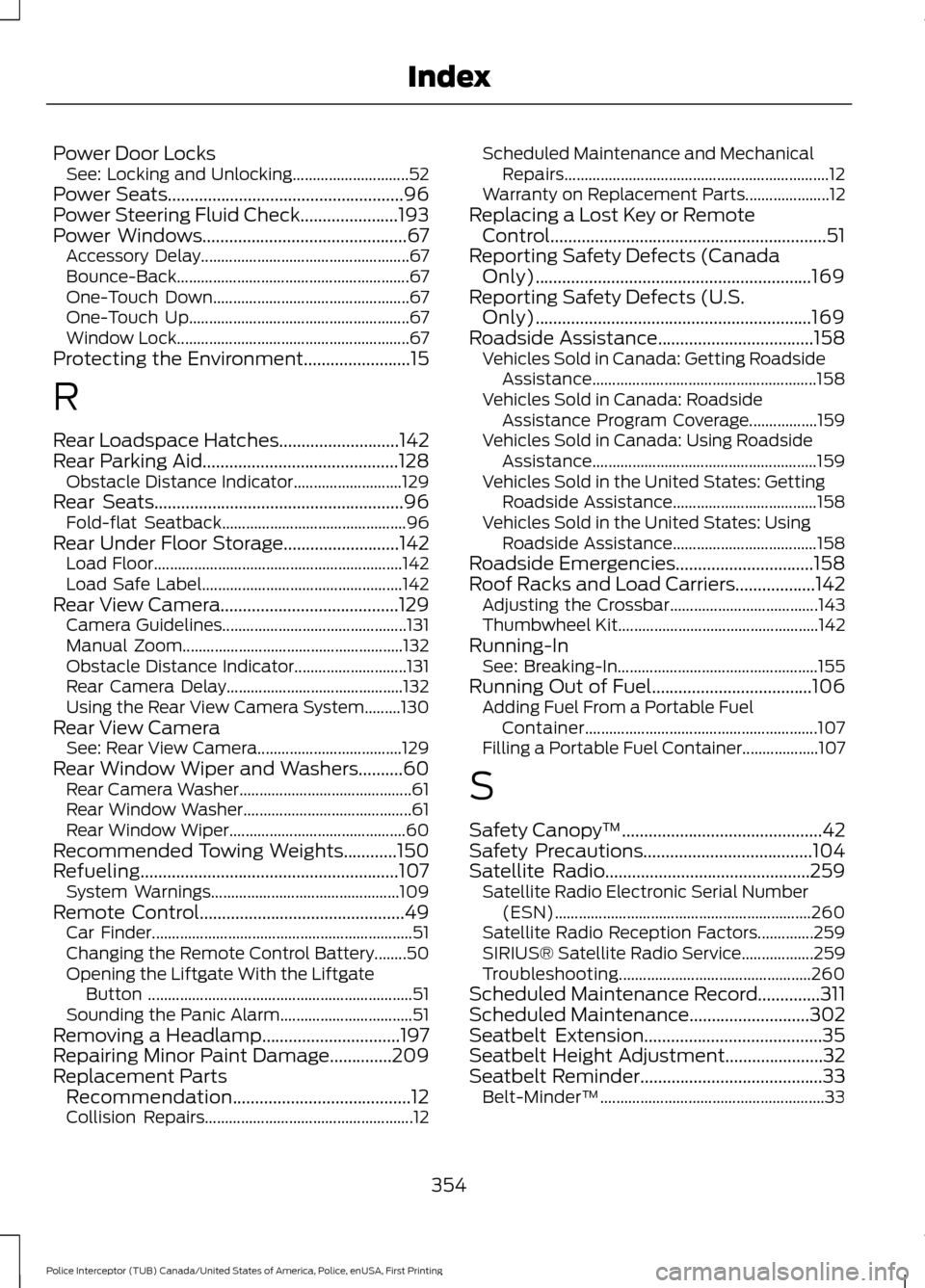
Power Door Locks
See: Locking and Unlocking............................. 52
Power Seats.....................................................96
Power Steering Fluid Check......................193
Power Windows..............................................67 Accessory Delay.................................................... 67
Bounce-Back.......................................................... 67
One-Touch Down................................................. 67
One-Touch Up....................................................... 67
Window Lock.......................................................... 67
Protecting the Environment........................15
R
Rear Loadspace Hatches...........................142
Rear Parking Aid
............................................128
Obstacle Distance Indicator........................... 129
Rear Seats
........................................................96
Fold-flat Seatback.............................................. 96
Rear Under Floor Storage..........................142 Load Floor.............................................................. 142
Load Safe Label.................................................. 142
Rear View Camera........................................129 Camera Guidelines.............................................. 131
Manual Zoom....................................................... 132
Obstacle Distance Indicator............................ 131
Rear Camera Delay............................................ 132
Using the Rear View Camera System.........130
Rear View Camera See: Rear View Camera.................................... 129
Rear Window Wiper and Washers..........60 Rear Camera Washer........................................... 61
Rear Window Washer.......................................... 61
Rear Window Wiper............................................ 60
Recommended Towing Weights
............150
Refueling..........................................................107 System Warnings............................................... 109
Remote Control
..............................................49
Car Finder................................................................. 51
Changing the Remote Control Battery........50
Opening the Liftgate With the Liftgate Button .................................................................. 51
Sounding the Panic Alarm................................. 51
Removing a Headlamp
...............................197
Repairing Minor Paint Damage..............209
Replacement Parts Recommendation........................................12
Collision Repairs.................................................... 12Scheduled Maintenance and Mechanical
Repairs.................................................................. 12
Warranty on Replacement Parts..................... 12
Replacing a Lost Key or Remote Control..............................................................51
Reporting Safety Defects (Canada Only)..............................................................169
Reporting Safety Defects (U.S. Only)..............................................................169
Roadside Assistance
...................................158
Vehicles Sold in Canada: Getting Roadside
Assistance........................................................ 158
Vehicles Sold in Canada: Roadside Assistance Program Coverage.................159
Vehicles Sold in Canada: Using Roadside Assistance........................................................ 159
Vehicles Sold in the United States: Getting Roadside Assistance.................................... 158
Vehicles Sold in the United States: Using Roadside Assistance.................................... 158
Roadside Emergencies...............................158
Roof Racks and Load Carriers..................142 Adjusting the Crossbar..................................... 143
Thumbwheel Kit.................................................. 142
Running-In See: Breaking-In.................................................. 155
Running Out of Fuel....................................106 Adding Fuel From a Portable Fuel
Container.......................................................... 107
Filling a Portable Fuel Container................... 107
S
Safety Canopy ™
.............................................42
Safety Precautions......................................104
Satellite Radio..............................................259 Satellite Radio Electronic Serial Number
(ESN)................................................................ 260
Satellite Radio Reception Factors..............259
SIRIUS® Satellite Radio Service.................. 259
Troubleshooting................................................ 260
Scheduled Maintenance Record..............311
Scheduled Maintenance...........................302
Seatbelt Extension
........................................35
Seatbelt Height Adjustment......................32
Seatbelt Reminder
.........................................33
Belt-Minder™........................................................ 33
354
Police Interceptor (TUB) Canada/United States of America, Police, enUSA, First Printing Index
Page 358 of 360
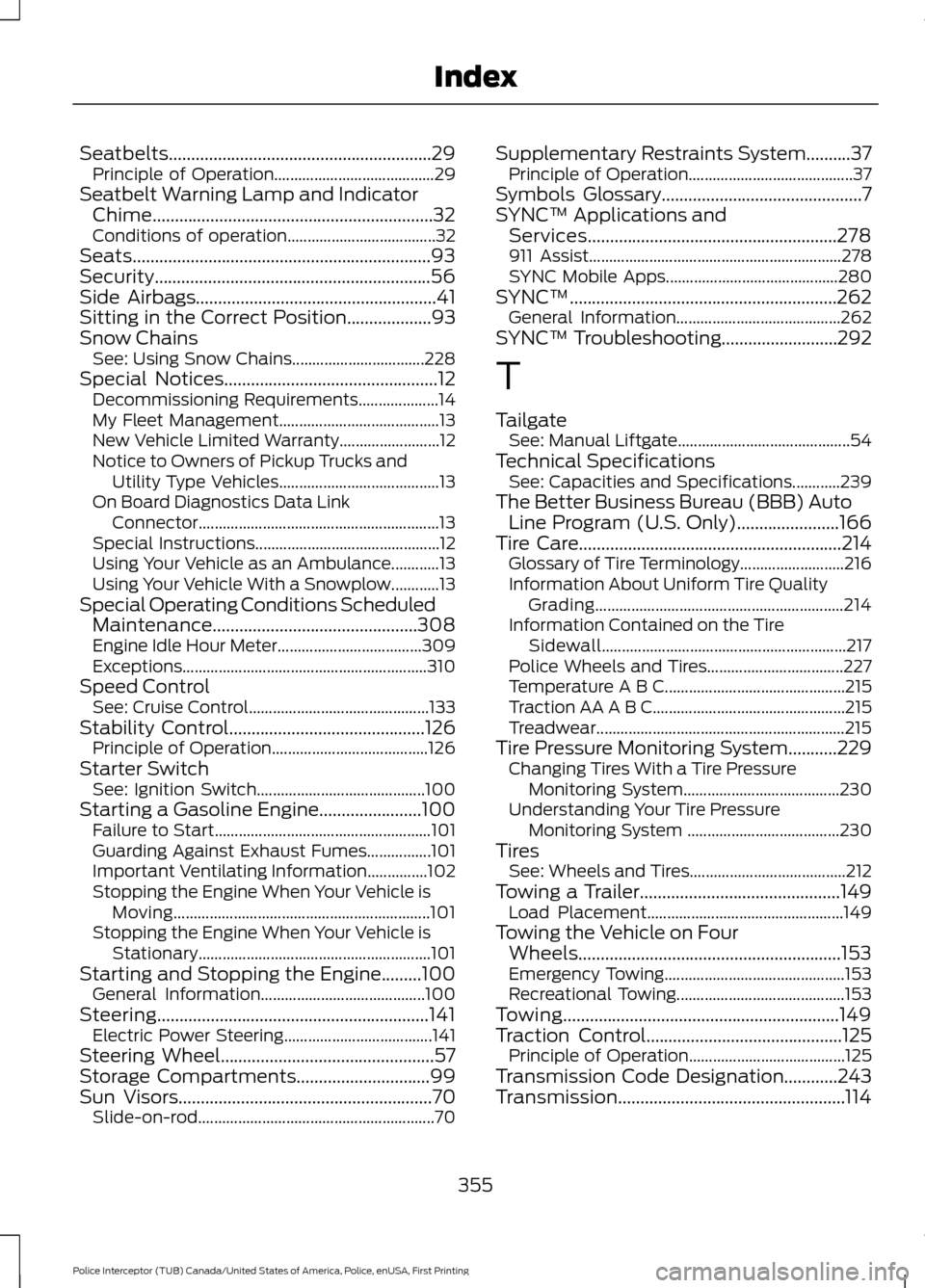
Seatbelts...........................................................29
Principle of Operation........................................ 29
Seatbelt Warning Lamp and Indicator Chime...............................................................32
Conditions of operation..................................... 32
Seats...................................................................93
Security..............................................................56
Side Airbags......................................................41
Sitting in the Correct Position...................93
Snow Chains See: Using Snow Chains................................. 228
Special Notices................................................12 Decommissioning Requirements.................... 14
My Fleet Management........................................ 13
New Vehicle Limited Warranty......................... 12
Notice to Owners of Pickup Trucks and Utility Type Vehicles........................................ 13
On Board Diagnostics Data Link Connector............................................................ 13
Special Instructions.............................................. 12
Using Your Vehicle as an Ambulance............13
Using Your Vehicle With a Snowplow............13
Special Operating Conditions Scheduled Maintenance..............................................308
Engine Idle Hour Meter.................................... 309
Exceptions............................................................. 310
Speed Control See: Cruise Control............................................. 133
Stability Control
............................................126
Principle of Operation....................................... 126
Starter Switch See: Ignition Switch.......................................... 100
Starting a Gasoline Engine.......................100 Failure to Start...................................................... 101
Guarding Against Exhaust Fumes................101
Important Ventilating Information...............102
Stopping the Engine When Your Vehicle is Moving................................................................ 101
Stopping the Engine When Your Vehicle is Stationary.......................................................... 101
Starting and Stopping the Engine.........100 General Information......................................... 100
Steering
.............................................................141
Electric Power Steering..................................... 141
Steering Wheel................................................57
Storage Compartments
..............................99
Sun Visors.........................................................70
Slide-on-rod........................................................... 70Supplementary Restraints System..........37
Principle of Operation......................................... 37
Symbols Glossary
.............................................7
SYNC™ Applications and Services........................................................278
911 Assist............................................................... 278
SYNC Mobile Apps........................................... 280
SYNC™
............................................................262
General Information......................................... 262
SYNC™ Troubleshooting
..........................292
T
Tailgate See: Manual Liftgate........................................... 54
Technical Specifications See: Capacities and Specifications............239
The Better Business Bureau (BBB) Auto Line Program (U.S. Only).......................166
Tire Care
...........................................................214
Glossary of Tire Terminology.......................... 216
Information About Uniform Tire Quality Grading.............................................................. 214
Information Contained on the Tire Sidewall............................................................. 217
Police Wheels and Tires.................................. 227
Temperature A B C............................................. 215
Traction AA A B C................................................ 215
Treadwear.............................................................. 215
Tire Pressure Monitoring System
...........229
Changing Tires With a Tire Pressure
Monitoring System....................................... 230
Understanding Your Tire Pressure Monitoring System ...................................... 230
Tires See: Wheels and Tires....................................... 212
Towing a Trailer.............................................149 Load Placement................................................. 149
Towing the Vehicle on Four Wheels...........................................................153
Emergency Towing............................................. 153
Recreational Towing.......................................... 153
Towing..............................................................149
Traction Control
............................................125
Principle of Operation....................................... 125
Transmission Code Designation............243
Transmission...................................................114
355
Police Interceptor (TUB) Canada/United States of America, Police, enUSA, First Printing Index